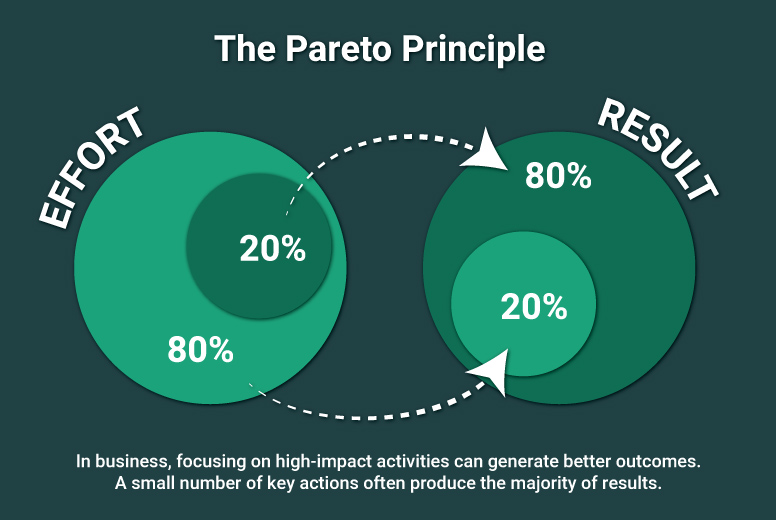Unleashing the Power of the Pareto Principle in Entrepreneurship

Last Updated: By Nagabhushanam Peddi
Ever wondered what separates wildly successful entrepreneurs from the rest? No, it’s not just hard work or luck. The secret ingredient is strategy — specifically, leveraging the Pareto Principle. This powerful concept is the uncelebrated mastermind behind countless success stories in the business world – and applying this principle could be the key to unlocking your own entrepreneurial success.
The 80/20 Rule Explained

At its core, the Pareto Principle, also widely recognized as the 80/20 rule, is all about disproportionate impact. But how did this observation turn into one of the most prevalent business and productivity strategies today?
Vilfredo Pareto, an Italian economist in the 1900s, stumbled upon an intriguing pattern in his home country: 80% of Italy’s land was in the hands of a mere 20% of its population. This wasn’t just an isolated case of wealth distribution. As Pareto dug deeper, he discovered that this 80/20 pattern manifested itself in various scenarios and domains beyond land ownership.
From agriculture (where 20% of pea pods in his garden produced 80% of the peas) to economics and, eventually, management theories, the Pareto Principle began taking root. This disparity in distribution indicated that not all inputs (efforts, resources, time) yield equal outputs (results, revenue, value). Instead, a minority of causes often produce a majority of the results.
Now, let's bring this into the realm of entrepreneurship:
- Productivity: Consider your daily tasks. It’s likely that 20% of what you do each day contributes to 80% of your productivity and results. This could be strategic planning, relationship-building, or any high-impact task unique to your business.
- Sales: It’s not uncommon for businesses to find that 20% of their customers generate 80% of their sales. These are your high-value clients who purchase regularly or buy premium products.
- Marketing: Perhaps you use multiple channels to market your products or services. Among these, one or two channels (representing the vital 20%) might be driving the lion's share (80%) of your leads or conversions.
- Team Dynamics: Within a team, 20% of the members might be responsible for 80% of the overall results, highlighting the existence of key players who drive projects forward.
The power of the 80/20 rule lies not just in recognizing this imbalance but in leveraging it. By identifying the crucial 20% in any given scenario and dedicating more focus, resources, and energy to it, businesses can optimize results and efficiency. It’s about working smarter, not necessarily harder, and ensuring that every effort is directed towards what truly matters.
The Pareto Principle in Action
The Pareto Principle has been a silent driving force behind the strategies of some of the world's most iconic companies and personalities. Here are some examples of its power in action:
Apple
Believe it or not, usually, only a fraction of your product line generates most of your income. Case in point: Apple in 1997. The tech giant was on the verge of collapse when Steve Jobs took the reins as CEO and slashed their product line by 70%. He funneled resources into a few key products, turning Apple into an industry leader.
The overall lesson? Focus on what's truly driving your business and be ready to cut or evolve the rest.
Tim Ferriss and the 4-Hour Workweek
Is your to-do list endless, yet you feel stuck in a productivity rut? Take a leaf out of Tim Ferriss's book. The author of "The 4-Hour Workweek" mastered the art of working smart by identifying the 20% of tasks that contributed to 80% of his results. By focusing on these crucial tasks, Ferriss crafted a life marked by efficiency and freedom.
Dropbox
Not all marketing channels are created equal. Dropbox provides an incredible case study for this. In its infancy, Dropbox found that its referral program, only a small fraction of its overall strategy, was driving 35% of its daily sign-ups. Instead of spreading their efforts thin, they doubled down on this potent channel, resulting in a jaw-dropping 3900% growth in just 15 months.
Microsoft
Software giant Microsoft once discovered through its research that by fixing the top 20% of most reported bugs, they could eliminate 80% of the related errors and crashes. Instead of scattering resources on every single bug report, they honed in on the top issues, maximizing user satisfaction with fewer fixes.
Warren Buffett
One of the world's most successful investors, Warren Buffett, often shares the essence of the Pareto Principle in his investment strategy. He once said, "The truth is that I very seldom look at all the hundreds of businesses we own a piece of and spend the majority of my time pondering just a couple of them." Over the years, it's evident that a significant portion of Buffett's wealth comes from a small percentage of his investments.
LinkedIn's growth can also be attributed to a keen understanding of the 80/20 rule. Early on, they recognized that 20% of their features, like public profiles and search functionality, were driving 80% of their site traffic. Instead of diversifying too quickly, LinkedIn bolstered these core features, solidifying its place as the premier professional networking platform.
By studying these examples, it becomes clear that the Pareto Principle is not just an abstract concept but a tangible strategy adaptable across various sectors.
Leveraging the Pareto Principle for Your Startup
The 80/20 rule can be a game-changer for startups. By pinpointing the key actions that lead to the biggest results, leaders can make more informed decisions on resource allocation, strategy, and growth.
Here are some ways to apply the Pareto Principle across your business:
Product Focus
Just like Apple, assess your product lineup. Are there products/services taking up too many resources but not providing adequate returns? Consider simplifying your offerings and focusing on those that bring the most value to your business.
Prioritize Tasks
Identify the core tasks that drive the majority of your results. Spend more time and resources on these and consider delegating or even eliminating low-impact tasks.
Customer Evaluation
Often, 20% of customers account for 80% of profits. Identify these high-value clients and ensure they are satisfied. Conversely, recognize if there are high-maintenance, low-return clients that may not be worth the effort.
Marketing and Sales
Identify which channels are driving the majority of leads and conversions. By understanding this, you can allocate more resources to what's working and reconsider strategies that aren’t yielding results.
Decision-Making
Not all decisions are of equal importance. Focus on decisions that will have the most significant impact on your business. Sometimes, spending too much time on minor decisions can prevent you from making more impactful ones.
The Bottom Line
It’s easy to get lost chasing after the next big thing, novel idea, or revolutionary strategy. Yet, history and the Pareto Principle have shown us that insights and success often reside in the details, in understanding the nuances, and in making conscious choices.
Remember, entrepreneurship isn't always about breaking new ground. Sometimes, it's about discernment — knowing where to allocate your resources and efforts for maximum impact. After all, why settle for more when you can settle for better?


